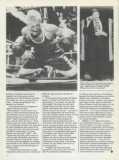

The one thing you can say about Popeye with any certainty is that it is a very peculiar movie. In fact, the only other movie I can think of that is remotely like it is Li‘l Abner and even there the similarities are on the surface. Like Popeye, Lil Abner brought grotesque comic strip characters to life on the screen in a musical format but Lil Abner was based on a stage show and the film was little more than a recording of that show with flat, painted backdrops and stylised sets. Popeye, on the other hand, is set very much in a real, threedimensional world and has been directed by someone whose name is synonymous with cinematic naturalism — Robert Altman.
All the usual Altman trademarks are present in Popeye: the overlapping dialogue overlaid with background sounds and fragments of half-heard conversations, and richly detailed background action in which the extras appear to be living separate lives of their own. At times I was strongly reminded of Altman's offbeat western McCabe and Mrs Miller, especially since the half-finished pioneer town in that movie and the ramshackle town of Sweethaven, where most of Popeye is set, are so similar (theres even a western-style house-of-ill-repute in Sweethaven, which has to be a first for a Disney film).
Now it has been said, with some justification, that Altman's idiosyncratic approach is the wrong one for a movie like Popeye and that a more straightforward directing style should have been more suitable but I disagree. I think its the clash between Altmans naturalism and the unreal subject matter that makes Popeye so interesting and unusual (its as if the backgrounds in a Bugs Bunny cartoon had been drawn by Hogarth).
[…]